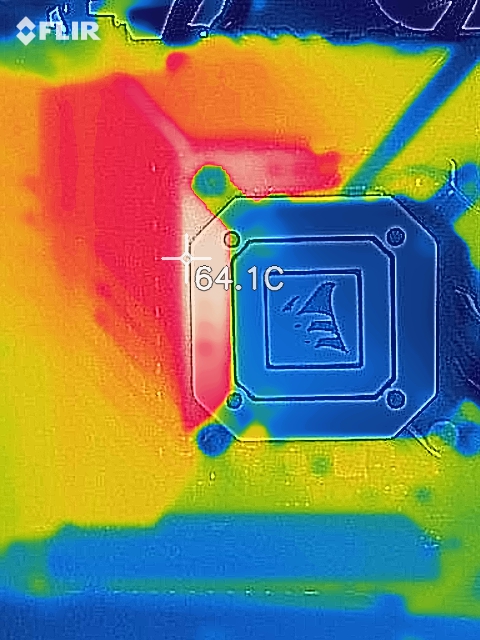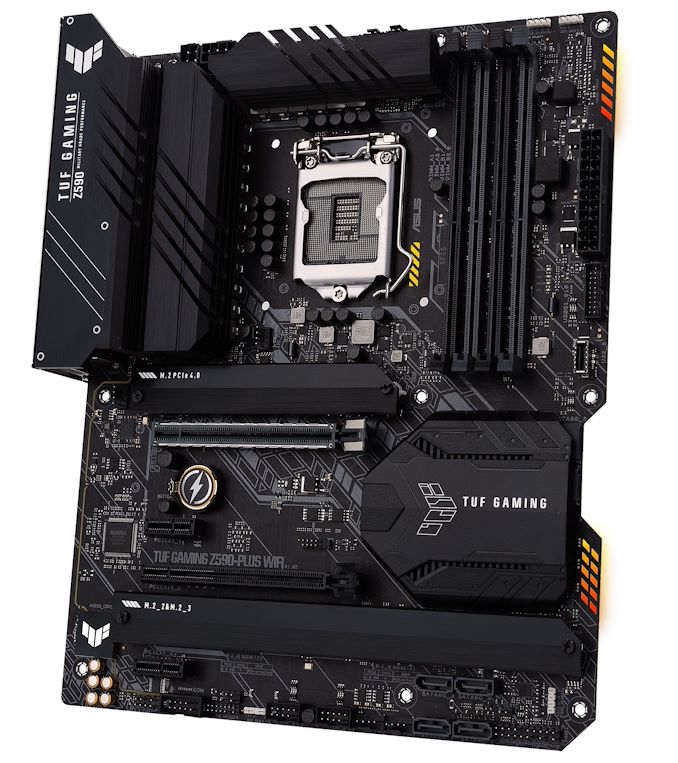ASUS TUF Gaming Z590-Plus WIFI Motherboard Review: Is $260 Mid-Range or High-End?
by Gavin Bonshor on August 10, 2021 10:00 AM EST_678x452.jpg)
Despite the Z590 chipset being the premium option for Intel 11th Gen Rocket Lake processors, and the boards starting around $200, not every model is there to decimate the wallet. Every vendor has models designed for entry-level, mid-range, and even the flagship models - it's all a question of where the vendor thinks those delineated markets are. Some boards certainly have eye-watering prices attached to them, for example. Focusing on the mid-range segment, today we're taking a look at the ASUS TUF Gaming Z590-Plus WIFI. Its most prominent features include three M.2 slots, USB 3.2 G2x2 Type-C support, and a solid pair of networking controllers, including Wi-Fi 6E and 2.5 gigabit Ethernet.
ASUS TUF Gaming Z590-Plus WIFI Overview
Because there are multiple options in terms of processors, platforms, chipsets, memory, and storage, looking for the next upgrade can be difficult. Since Intel's competitors started taking market share, the rush is on to offer something above and beyond the competition. This is exemplified by the sheer number of options available for upgrades. Focusing on Z590, its secret sauce lies in the features from the chipset, including native USB 3.2 G2x2 Type-C support, double the DMI bandwidth (x4 to x8) of previous generations of Intel, and support for better networking support via Wi-Fi 6E.
Back in the day, TUF stood for ‘The Ultimate Force’ and was one the designation for ASUS’s robust series of motherboards. It spawned the Sabertooth series, clad in armor, looking clean, and offering superb value to users. ASUS decided to rebrand its TUF series back in 2017 to a more gamer-friendly brand, which is now known today as TUF Gaming. This series is designed to provide gamers with all the tools it needs to benefit from the performance. Still, ultimately, it sits as its entry-level to mid-range opener behind its core Republic of Gamers (ROG) models, with Strix sitting in the middle.
One such option available to users is the ASUS TUF Gaming Z590-Plus WIFI, which sits as one of the more affordable offerings but without sacrificing too much of Z590’s core feature set. When it comes to motherboards, money doesn’t go as far as it once did five years ago, and that’s due to multiple things, including more expensive yet better premium controllers, new features, and a general market shift which is apparent in the present climate.
Decked out from head to toe in all-black heatsinks, the ASUS TUF Gaming Z590-Plus WIFI has a simple yet well contrasted aesthetic, which includes a grey and black patterned PCB with integrated RGB LEDs on the right-hand side of the board. Interestingly from a design point of view ASUS is using its X-shaped cut-out around the SATA area, with two easily accessible right-angled SATA ports, in addition to four straight-angled SATA ports bringing the board’s total to six. Other storage options include one fully-fledged PCIe 4.0 x4 M.2 slot, with two additional PCIe 3.0 x4/SATA M.2 slots, which all benefit from ASUS M.2 heatsinks. Expansion support includes one full-length PCIe 4.0 x16 slot, with a second full-length PCIe 3.0 x4 and two additional PCIe 3.0 x1 slots.
Some of the ASUS TUF Gaming Z590-Plus WIFI’s primary features include WI-Fi 6 networking, in addition to one 2.5 gigabit Ethernet port, cementing that 2.5 GbE is becoming more and more frequent across the entry-level and mid-range over the last 9-12 months. ASUS also includes a premium HD audio codec and tapping into Intel Z590’s native USB 3.2 G2x2 Type-C support on the rear panel. With refinements to Intel’s Rocket Lake processors regarding memory, the Z590-Plus WIFI includes support for up to DDR4-5133 out of the box, with four memory slots providing capacities of up to 128 GB.
Focusing on performance, the ASUS TUF Gaming Z590-Plus WIFI performed competitively in our power testing, with respectable figures in long idle, idle, and at full-load. In our system POST time test, the ASUS did well, but in our DPC latency testing, we saw worse than average performance compared to other Z590 models on test. In our computational and gaming-focused tests, the ASUS again performed with credit and stretched its legs in our custom Crysis CPU render test. Other results did remain competitive with other Z590 models tested so far.

The ASUS TUF Gaming Z590-Plus WIFI undergoing our VRM thermal testing
In our overclock testing, the board’s inability to hit 5.2 GHz all-core stable with our Core i9-11900K processor was somewhat disappointing. Even with a hefty 1.45 V on the CPU VCore, it just didn’t want to play ball, and we know this processor does 5.3 GHz in some motherboards. Regarding VDroop performance, we were mostly satisfied with what we saw. Despite the ability to hit 5.2 GHz stable, we feel that the TUF Gaming Z590-Plus WIFI represents its pedigree and price point. Our thermal VRM performance figures also put the ASUS in a positive light. It performed as we would have expected with a variance of between 66 and 71°C between the integrated thermal sensor and our K-Type thermocouples.
With a current selling price of $259 (at the time of writing), this puts the ASUS TUF Gaming Z590-Plus WIFI in the same price range as many other models. This includes the GIGABYTE Z590 Aorus Pro AX ($270), the MSI MAG Z590 Tomahawk WIFI ($270), and the ASRock Z590 Extreme WIFI 6E ($248). In the grand scheme of things, the ASUS includes Wi-Fi 6 over Wi-Fi 6E which is slightly disappointing given cheaper models from other vendors include this. ASUS does however include 2.5 Gigabit Ethernet, triple M.2, PCIe 4.0 support, which makes it competitive for the price. Although the aforementioned competitor's models include better onboard audio solutions, the ASUS and its lower price puts it in a solid position for users looking for a sub $300 model to build a Rocket Lake based system.
Read on for our extended analysis.











23 Comments
View All Comments
Arcadianu9 - Tuesday, August 10, 2021 - link
I would have liked to see the performance with one of the faster M.2 storage devices, and different configurations across the PCIe Gen4 and Gen3 connectors. The Crucial MX300 appears to be a SATA drive, which leaves a ton of performance on the table.Leeea - Tuesday, August 10, 2021 - link
What is weird about this is the ASUS TUF Gaming X570-PRO (WiFi 6) is both cheaper at $220 and is superior.That $40 difference also goes a long way to cover the difference in cost between
Wrs - Tuesday, August 10, 2021 - link
That’s AMD. The pins are on the CPU so the CPU is more expensive to match. Additionally Rocket Lake draws more instantaneous current so the boards need more VRMs. The AMD board’s second slot is PCIe-4, but it’s missing the third M2 slot as well as front USB-CLeeea - Tuesday, August 10, 2021 - link
The x570-Pro has the front and back USB-C ports. ( I have one sitting two feet from me )It also has 2x more SATA lines, BIOS flashback, PCIe 4 slots, multiple graphics card slots (the reviewed board indicates it only has one), and both m2 slots are PCIe 4.
The additional m2 slot on the z590 is an advantage, but cheap adaptors exist for converting PCIe 4.0 slots to m.2.
Yea, the different socket does cost more then the AMD equivalent, but ironically the CPU the board was reviewed with, the i9-11900K, costs a $150 more then its AMD equivalent 5800x.
Wrs - Tuesday, August 10, 2021 - link
Whoops, sorry about the USB-C front.For price comparisons I'd never match AMD's mid-range to Intel's top-end. The mobo+CPU comparison is far closer between 5800X/Z570 and 11700KF/Z590. The nice thing is street prices have been adjusting to relative performance & availability. Intel is obviously sweating on 14nm as they don't have any 12- or 16-core K competitor, plus they're cutting Rocket Lake below MSRP as it merely throws punches vs. a 5800x and is a bit behind in gaming and very much in power efficiency.
The PCI-e 4 lanes on x570 aren't always an advantage here, btw. See, Ryzen 3000 & 5000 only have 24 PCIe-4 lanes coming out of the SOC. In the TUF series, 16 are used for the first graphics slot and 4 for the first M2 slot, leaving 4 for the chipset to spread out between the second x16 graphics slot, second M2, and many of those USB links and Wifi. On Rocket Lake, 20 PCIe-4 lanes are used for the same graphics and M2 slots, but then 8 PCIe-3 lanes go to the chipset. The second x16 slot on both TUF boards is electrically just x4, but on the Intel version the halved bandwidth is accompanied by much less resource contention. This is primarily evident if you're using both a second M2 and multiple PCI-e cards on both boards - the simultaneous bandwidth off the chipsets is identical.
Leeea - Wednesday, August 11, 2021 - link
If I could upvote your post I would. :)supdawgwtfd - Wednesday, August 11, 2021 - link
8x gen3 lanes have the same bandwidth as 4x gen 4 lanes.Based on your comments the choosers would have the same bandwidth to the CPU?
What point we're you tryjg to make?
Threska - Tuesday, August 10, 2021 - link
"Although the aforementioned competitor's models include better onboard audio solutions, the ASUS and its lower price puts it in a solid position for users looking for a sub $300 model to build a Rocket Lake based system."But how many use the onboard audio anyway? Even the GPU has an onboard solution.
neothe0ne - Tuesday, August 10, 2021 - link
The vast majority of desktop computers use onboard sound from the motherboard. I'd guess that the market for cheap (e.g., sub-$150) DAC's/cards is just for people who buy a motherboard with a subpar Realtek audio implementation that lets them hear all their computer noise crystal clear.Operandi - Tuesday, August 10, 2021 - link
This isn't the early 00s DACs are easy these days as is evident by how many people use onboard audio (even with decent headphones or speakers) which is nearly everyone.